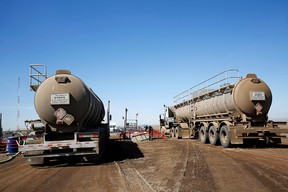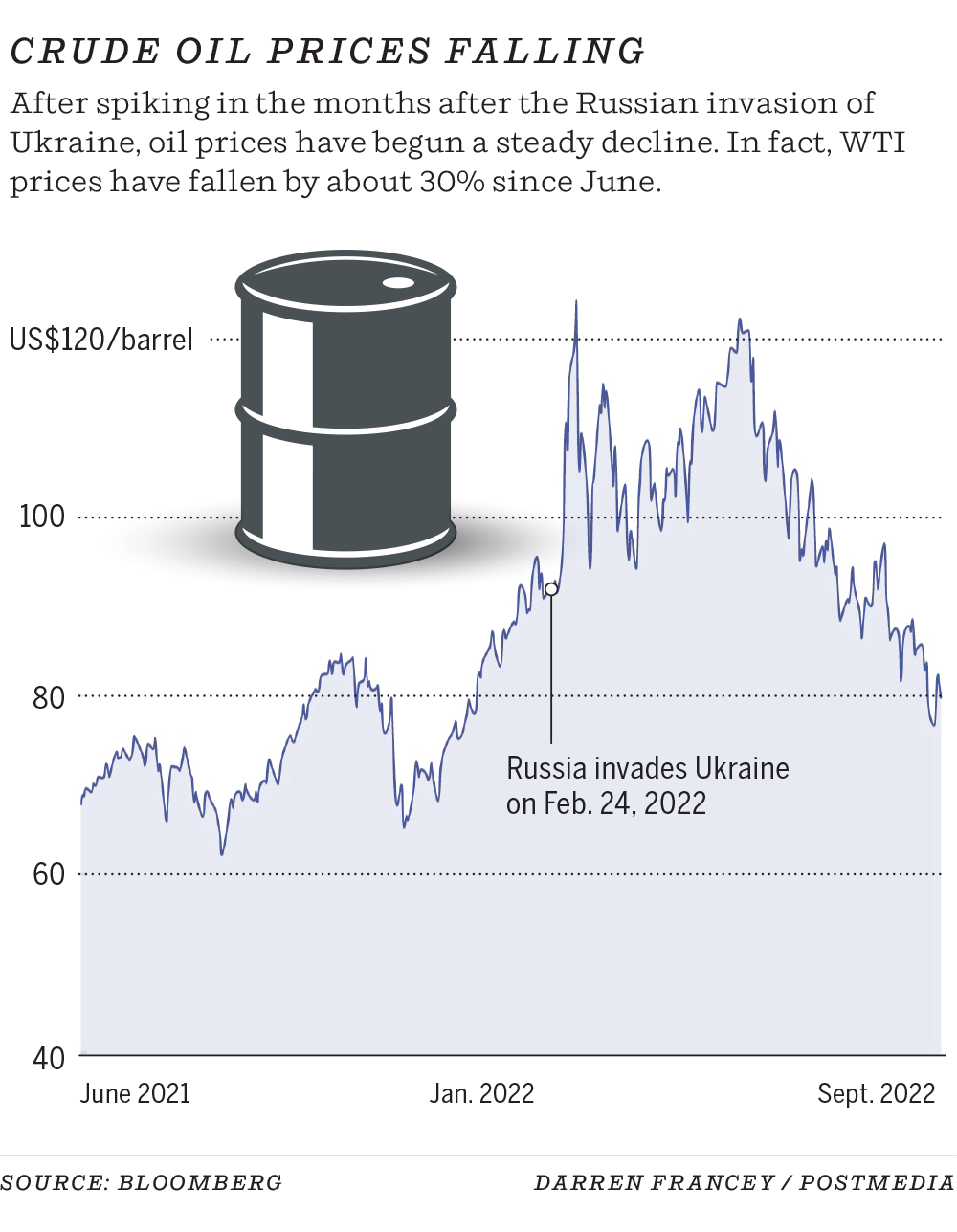Oil producers are drawing up their spending plans for the coming year, and two conflicting forces are at play: falling oil prices and a falling Canadian dollar.

.
The annual season for Canadian oil producers drawing up their spending plans for the coming year is underway, and it came with two conflicting forces at play: falling oil prices and the fallout from a declining Canadian dollar.
Announcement 2
.
Benchmark U.S. crude prices have retreated from early June highs of $120 a barrel to recently fall below $80 amid growing concerns that a looming global recession could reduce demand. . West Texas Intermediate crude settled Friday at $79.49 a barrel, down $1.74.
.
Analysts say the drop has taken some of the steam out of expected 2023 budget increases.
“This volatility in the markets with oil prices and equity prices is putting a lot of increased capital budgets on hold,” said analyst Jeremy McCrea at Raymond James.
“There is less and less confidence in the direction of commodity prices over the next year.”
On the other hand, the Canadian dollar is falling against the rising US dollar.
A lower Canadian dollar reinforces the performance of domestic crude and natural gas sold in US currency, and is helping producers absorb some of the turbulence.
Announcement 3
.
Earlier this week, Whitecap Resources became one of the first Canadian producers to release its spending plan for the coming year, announcing a capital budget of $925 million.
It expects to drill around 250 wells in Saskatchewan, Alberta and British Columbia, following Whitecap’s successful $1.9 billion acquisition of XTO Energy Canada in June.
-
Recession proof? Alberta economy expected to stave off Canadian GDP contraction
-
Whitecap Resources secures largest acquisition in its history by taking over XTO Energy for $1.9 billion
-
As oil prices soar, Alberta’s energy production will increase 52% in value, topping $163 billion this year
The acquisition makes apples-to-apples comparisons between this year’s budget and the 2023 budget tricky; Whitecap’s capital expenditures are pegged at $680 million in 2022.
Announcement 4
.
In a conference call with analysts on Wednesday, Chief Financial Officer Thanh Kang noted that every $5 per barrel change in WTI alters Whitecap’s cash flow by $110 million annually.
However, a five-cent drop in the Canadian dollar to 73 cents against the US dollar has recently “protected” the company from falling oil prices, improving its cash flow levels by $135 million, it said.
Even with “significant volatility, the commodity price environment remains strong, especially in light of Canadian dollar weakness,” CEO Grant Fagerheim said.
On Friday, Birchcliff Energy executives met in Lake Louise for a planning session, including preparing for their 2023 activities.
“We have more computer executions of different scenarios than you can shake a fist. You have so many variables,” Birchcliff CEO Jeff Tonken said in an interview.
ad 5
.
Analysts say volatility is the order of the day, and for the next year, given pressures from rising inflation, job constraints, uncertain geopolitical forces and fears of a global recession.
Overall industry spending rose in 2022 on strong commodity prices, though still well below 2014 levels, when crude prices previously topped $100 a barrel and major tar sands projects moved forward.
During the second quarter of the year, industry capital spending on extraction reached $9.3 billion, its highest point since 2018, according to Statistics Canada.
Alberta Energy Minister Sonya Savage noted that provincial land lease sales and drilling activity levels also increased, aAlthough the discount facing Western Canadian Select heavy oil has widened in recent months.
ad 6
.
The province estimates that investment in oil and gas in Alberta this year will rise nearly 35 percent from 2021 levels.
“Our (provincial) budget is based on $70 a barrel of oil and our industry is profitable even at much lower prices,” Savage said in an interview.
“I don’t expect the oil price to stay below $80. I’m pretty sure it’s going to go up and I’m not worried about capex either. The industry is quite optimistic.”

Precision Drilling Corp. CEO Kevin Neveu noted that the Calgary-based company had 67 rigs working in Canada this week. That’s just down from the peak of 72 active rigs last winter, typically the busiest season for the sector.
He anticipates strong drilling activity in the Montney formation and the Clearwater heavy oil field next year. Although oil prices have fallen, customers have “room to work with” as they have spent less than their cash flow levels reach.
ad 7
.
“We expect the demand for drilling and services to increase in 2023. I would say it is at least five percent, maybe even 10 percent,” Neveu added.
While spending in the sector is expected to rise, part of that is due to inflation. Even if companies would like to invest much more money, they face bottlenecks due to labor and equipment limitations.
“We don’t expect a sea change in activity,” said oilfield services analyst Tim Monachello of ATB Capital Markets. “It’s just kind of a modest growth.”
And there is a positive force helping the industry this fall: the rapidly falling Canadian dollar. The Canadian dollar fell to a two-year low earlier this week and fell to 72.96 US cents on Thursday.
ad 8
.
Even with falling oil prices, WTI crude oil prices are hovering around $110 a barrel in Canadian dollars, while Western Canadian Select heavy oil hovers around $80, according to a report by Eight. Capital on Friday.
“In Canadian dollars, oil prices are almost 40 percent higher than what you’d see in US dollars, so that’s pretty significant,” he said. Phil Skolnick, an analyst at Eight Capital.
At Birchcliff, Tonken noted that the company sells 87 percent of its natural gas in US dollars. He also anticipates that natural gas prices will remain healthy next year.
Additionally, the company expects to be debt-free by the end of this year, reducing some of the risks from commodity markets and unpredictable exchange rates.
Tonken expects spending across the Canadian sector to be “measured and balanced” by 2023.
“I don’t think you’re going to see a lot of growth. You will see some growth from some companies,” she added.
“We are full of optimism…but we don’t see any giant drill programs that are going to increase production materially.”
Chris Varcoe is a columnist for the Calgary Herald.





